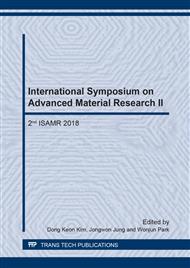[1]
S. Cheng, Y. Zhang, R. Cha, J. Yang, X. Jiang, Water-soluble nanocrystalline cellulose films with highly transparent and oxygen barrier properties, Nanoscale 8 (2016) 973-978.
DOI: 10.1039/c5nr07647a
Google Scholar
[2]
S. S. Nair, J. Y. Zhu, Y. Deng, A. J. Ragauskas, High performance green barriers based on nanocellulose, Sustain. Chem. Proc. 2 (2014) 23-30.
DOI: 10.1186/s40508-014-0023-0
Google Scholar
[3]
Z. Hanif, H. Jeon, T. H. Tran, J. Jegal, S. A. Park, S. M. Kim, J. Park, S. Y. Hwang, D. X. Oh, Butanol-mediated oven-drying of nanocellulose with enhanced dehydration rate and aqueous re-dispersion, J. Polym. Res. 24 (2017) 191.
DOI: 10.1007/s10965-017-1343-z
Google Scholar
[4]
H. L. Nguyen, Y. K. Jo, M. Cha, Y. J. Cha, D. K. Yoon, N. D. Sanandiya, D. S. Hwang, Mussel-inspired anisotropic nanocellulose and silver nanoparticle composite with improved mechanical properties, electrical conductivity and antibacterial activity, Polym. 8 (2016).
DOI: 10.3390/polym8030102
Google Scholar
[5]
K. Gao, Z. Shao, X. Wu, X. Wang, J. Li, Y. Zhang, F. Wang, Cellulose nanofibers/reduced graphene oxide flexible transparent conductive paper, Carbohydrate Polym. 97 (2013) 243-251.
DOI: 10.1016/j.carbpol.2013.03.067
Google Scholar
[6]
H. Fukuzumi, T. Saito, T. Iwata, Y. Kumamoto, A. Isogai, Transparent and high gas barrier films of cellulose nanofibers prepared by TEMPO-mediated oxidation, Biomacromolecules 10 (2008) 162-165.
DOI: 10.1021/bm801065u
Google Scholar
[7]
S. Fujisawa, Y. Okita, H. Fukuzumi, T. Saito, A. Isogai, Preparation and characterization of TEMPO-oxidized cellulose nanofibril films with free carboxyl groups, Carbohydrate Polym. 84 (2011) 579-583.
DOI: 10.1016/j.carbpol.2010.12.029
Google Scholar
[8]
C. Aulin, M. Gällstedt, T. Lindström, Oxygen and oil barrier properties of microfibrillated cellulose films and coatings, Cellulose 17 (2010) 559-574.
DOI: 10.1007/s10570-009-9393-y
Google Scholar
[9]
G. Rodionova, T. Saito, M. Lenes, Ø. Eriksen, Ø. Gregersen, H. Fukuzumi, A. Isogai, Mechanical and oxygen barrier properties of films prepared from fibrillated dispersions of TEMPO-oxidized Norway spruce and Eucalyptus pulps, Cellulose 19 (2012).
DOI: 10.1007/s10570-012-9664-x
Google Scholar
[10]
Q. Yang, H. Fukuzumi, T. Saito, A. Isogai, L. Zhang, Transparent cellulose films with high gas barrier properties fabricated from aqueous alkali/urea solutions, Biomacromolecules 12 (2011) 2766-2771.
DOI: 10.1021/bm200766v
Google Scholar
[11]
D.C. Rodger, J.D. Weiland, M.S. Humayun, Y.C. Tai, Scalable high lead-count parylene package for retinal prostheses, Sensors and Actuators B: Chemical 117 (2006) 107-114.
DOI: 10.1016/j.snb.2005.11.010
Google Scholar
[12]
C. Hassler, R. P. von Metzen, P. Ruther, T. Stieglitz, Characterization of parylene C as an encapsulation material for implanted neural prostheses, J. Biomed. Mater. Res. Part B: Appl. Biomater. 93 (2010) 266-274.
DOI: 10.1002/jbm.b.31584
Google Scholar
[13]
D. Wright, B. Rajalingam, J. M. Karp, S. Selvarasah, Y. Ling, J. Yeh, A. Khademhosseini, Reusable, reversibly sealable parylene membranes for cell and protein patterning, J. Biomed. Mater. Res. Part A 85 (2008) 530-538.
DOI: 10.1002/jbm.a.31281
Google Scholar


